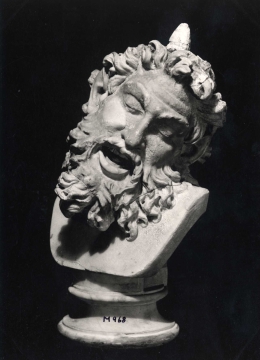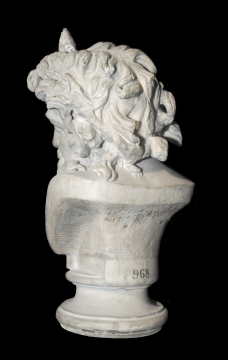Explore Collections


You are here:
CollectionsOnline
/
Roman head of a sleeping Pan
Browse
Roman head of a sleeping Pan
Roman, after an original of the second century BC
Pentelic marble
Height: 41cm
Height (excluding pedestal and base): 33cm
Height (head, excluding restorations): 23.5cm
Height (excluding pedestal and base): 33cm
Height (head, excluding restorations): 23.5cm
Museum number: M968
On display: Dome Area
All spaces are in No. 13 Lincoln's Inn Fields unless identified as in No. 12, Soane's first house.
For tours https://www.soane.org/your-visit
Curatorial note
Pan, the God of Nature and of shepherds and their flocks is show here with eyes closed, mouth open and tongue and teeth showing, lying turned towards his left shoulder as if relaxed in sleep.
The closest parallel resemblance for this Pan type in general is the terracotta bust in Athens.1 Before the extensive restorations, which are, however, quite accurate, this Soane head probably appeared similar to a weathered and broken head in the Vatican Magazine, which represents a smiling Pan with eyes which were once inlaid.2
This head is good decorative work, probably after an original of the second century BC, although the restoration makes further conclusions difficult. The indication of the teeth, the tongue, and the hollow mouth, although rare in antique sculpture, would be expected in works of this nature. Statues with the cruder Pan features, such as those of the standing Pan in the vestibule of the Villa Borghese3 which is in excellent antique condition, or the Pan group in Naples4, exhibit the same open mouth and five upper front teeth.
There is another bust, in the Museo Torlonia, Rome5 which, while not representing Pan but rather an elderly barbarian or perhaps even a Hellenistic philosopher of the Pergamene school, has a number of stylistic and technical features which give it a striking likeness to the Soane Pan. It features the same striking turn of the head, for example, and judging from what remains of the Soane head, has the same rather individually hemp-like treatment of locks of hair.
An unrestored, very naturalistic head of the animal-faced Pan in the Detroit Institute of Arts (described as a Satyr; Jacob Hirsch Collection), gives a perfect impression of the appearance the Soane Museum Pan presented in its pristine condition. The Detroit Pan has been termed a post-classical creation, but the same measure of Hellenistic earthiness defines both sculptures. Carved in Parian Marble, the Pan in Detroit is said to have been found at Porto d'Anzio6.
1 Mitteilungen des deutschen archäologischen Instituts, Athenische Abteilung, 1878, pl. 8; R. Herbig, Pan, Frankfurt am Main, 1949, pl. XXVII, 1, note 165a.
2 G. K. von Weinberg, Sculture del Magazzino del Museo Vaticano, 2 vols, Vatican City, 1937, no.191, pl. XXXVII.
3 No. CCXXXV; Paola della Pergola, Borghese Gallery, p. 5.
4 W. Klein, in Jahreshefte des Oesterreichischen Archäologischen Institutes, XIX-XX, 1919, pp. 261ff., fig. 178.
5 P.E. Visconti, Catalogo del Museo Torlonia di Sculture Antiche (Album of Plates), plate CXVII, no. 457.
6 Detroit IOA accession no. 49.520. See Bulletin of the Detroit Institute of Arts, Volume XXXI, No. 3-4, 1951-1952, p. 66.
The closest parallel resemblance for this Pan type in general is the terracotta bust in Athens.1 Before the extensive restorations, which are, however, quite accurate, this Soane head probably appeared similar to a weathered and broken head in the Vatican Magazine, which represents a smiling Pan with eyes which were once inlaid.2
This head is good decorative work, probably after an original of the second century BC, although the restoration makes further conclusions difficult. The indication of the teeth, the tongue, and the hollow mouth, although rare in antique sculpture, would be expected in works of this nature. Statues with the cruder Pan features, such as those of the standing Pan in the vestibule of the Villa Borghese3 which is in excellent antique condition, or the Pan group in Naples4, exhibit the same open mouth and five upper front teeth.
There is another bust, in the Museo Torlonia, Rome5 which, while not representing Pan but rather an elderly barbarian or perhaps even a Hellenistic philosopher of the Pergamene school, has a number of stylistic and technical features which give it a striking likeness to the Soane Pan. It features the same striking turn of the head, for example, and judging from what remains of the Soane head, has the same rather individually hemp-like treatment of locks of hair.
An unrestored, very naturalistic head of the animal-faced Pan in the Detroit Institute of Arts (described as a Satyr; Jacob Hirsch Collection), gives a perfect impression of the appearance the Soane Museum Pan presented in its pristine condition. The Detroit Pan has been termed a post-classical creation, but the same measure of Hellenistic earthiness defines both sculptures. Carved in Parian Marble, the Pan in Detroit is said to have been found at Porto d'Anzio6.
1 Mitteilungen des deutschen archäologischen Instituts, Athenische Abteilung, 1878, pl. 8; R. Herbig, Pan, Frankfurt am Main, 1949, pl. XXVII, 1, note 165a.
2 G. K. von Weinberg, Sculture del Magazzino del Museo Vaticano, 2 vols, Vatican City, 1937, no.191, pl. XXXVII.
3 No. CCXXXV; Paola della Pergola, Borghese Gallery, p. 5.
4 W. Klein, in Jahreshefte des Oesterreichischen Archäologischen Institutes, XIX-XX, 1919, pp. 261ff., fig. 178.
5 P.E. Visconti, Catalogo del Museo Torlonia di Sculture Antiche (Album of Plates), plate CXVII, no. 457.
6 Detroit IOA accession no. 49.520. See Bulletin of the Detroit Institute of Arts, Volume XXXI, No. 3-4, 1951-1952, p. 66.
Unrecorded
Literature
A. Michaelis, Ancient Marbles of Great Britain, trans. C.A.M. Fennell, Cambridge, 1892, p.475, no. 9.
Vermeule/Bothmer, American Journal of Archaeology, 1959, p. 331.
Vermeule/Bothmer, American Journal of Archaeology, 1959, p. 331.
Soane collections online is being continually updated. If you wish to find out more or if you have any further information about this object please contact us: worksofart@soane.org.uk





